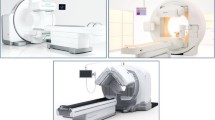Abstract
Improvements in image quality and quantitation measurement, and the addition of detailed anatomical structures are important topics for single-photon emission tomography (SPECT). The goal of this study was to develop a practical system enabling both nonuniform attenuation correction and image fusion of SPECT images by means of high-performance X-ray computed tomography (CT). A SPECT system and a helical X-ray CT system were placed next to each other and linked with Ethernet. To avoid positional differences between the SPECT and X-ray CT studies, identical flat patient tables were used for both scans; body distortion was minimized with laser beams from the upper and lateral directions to detect the position of the skin surface. For the raw projection data of SPECT, a scatter correction was performed with the triple energy window method. Image fusion of the X-ray CT and SPECT images was performed automatically by auto-registration of fiducial markers attached to the skin surface. After registration of the X-ray CT and SPECT images, an X-ray CT-derived attenuation map was created with the calibration curve for99mTc. The SPECT images were then reconstructed with scatter and attenuation correction by means of a maximum likelihood expectation maximization algorithm. This system was evaluated in torso and cylindlical phantoms and in 4 patients referred for myocardial SPECT imaging with Tc-99m tetrofosmin. In the torso phantom study, the SPECT and X-ray CT images overlapped exactly on the computer display. After scatter and attenuation correction, the artifactual activity reduction in the inferior wall of the myocardium improved. Conversely, the increased activity around the torso surface and the lungs was reduced. In the abdomen, the liver activity, which was originally uniform, had recovered after scatter and attenuation correction processing. The clinical study also showed good overlapping of cardiac and skin surface outlines on the fused SPECT and X-ray CT images. The effectiveness of the scatter and attenuation correction process was similar to that observed in the phantom study. Because the total time required for computer processing was less than 10 minutes, this method of attenuation correction and image fusion for SPECT images is expected to become popular in clinical practice.
Similar content being viewed by others
References
Malko JA, Heertum RLV, Gullberg GT, Kowalsky WP. SPECT liver imaging using an iterative attenuation correction algorithm and an external flood source.J Nucl Med 1986; 27: 701–705.
Bailey DL, Hutton BF, Walker PJ. Improved SPECT using simultaneous emission and transmission tomography.J Nucl Med 1987; 28: 844–851.
Manglos SH, Bassano DA, Thomas D, Grossman ZD. Imaging of the human torso using cone-beam transmission CT implemented on a rotating gamma camera.J Nucl Med 1992; 33: 150–156.
Galt JR, Cullom SJ, Garcia EV. SPECT quantification: a simplified method of attenuation and scatter correction for cardiac imaging.J Nucl Med 1992; 33: 2232–2237.
Frey EC, Tsui BMW, Perry JR. Simultaneous acquisition of emission and transmission data for improved thallium-201 cardiac SPECT imaging using a technetium-99m transmission source.J Nucl Med 1992; 33: 2238–2245.
Jaszczak RJ, Gilland DR, Hanson MW, Jang S, Greer KL, Coleman RE. Fast transmission CT for determining attenuation maps using a collimated line source, rotatable aircopper-lead attenuators and fan-beam collimation.J Nucl Med 1993; 34: 1577–1586.
Tan P, Bailey DL, Meikle SR, Eberl S, Fulton RR, Hutton B. A scanning line source for simultaneous emission and transmission measurements in SPECT.J Nucl Med 1993; 34: 1752–1760.
Ficaro EP, Fessler JA, Ackermann RJ, Rogers WL, Corbett JR, Schwaiger M. Simultaneous transmission-emission thallium-201 cardiac SPECT: effect of attenuation correction on myocardial tracer distribution.J Nucl Med 1995; 36: 921–931.
Celler A, Sitek A, Stoub E, Hawman P, Harrop R, Lyster D. Multiple line source array for SPECT transmission scans: simulation, phantom and patient studies.J Nucl Med 1998; 39: 2183–2189.
Fleming JS. A technique for using CT images in attenuation correction and quantification in SPECT.Nucl Med Commun 1989; 10: 83–92.
Damen EMP, Muller SH, Boersma LJ, Boer RW, Lebesque JV. Quantifying local lung perfusion and ventilation using correlated SPECT and CT data.J Nucl Med 1994; 35: 784–792.
Koral KF, Zasadny KR, Kessler ML, Luo JQ, Buchbinder SF, Kaminski MS, et al. CT-SPECT fusion plus conjugate views for determining dosimetry in iodine-131-monoclonal antibody therapy of lymphoma patients.J Nucl Med 1994; 35: 1714–1720.
Blankespoor SC, Wu X, Kalki K, Brown JK, Tang HR, Cann CE, et al. Attenuation correction of SPECT using X-ray CT on an emission-transmission CT system: myocardial perfusion assessment.IEEE Trans Nucl Sci 1996; 43: 2263–2274.
Bocher M, Balan A, Krausz Y, Shrem Y, Lonn A, Wilk M, et al. Gamma camera-mounted anatomical X-ray tomography: technology, system characteristics and first images.Eur J Nucl Med 2000; 27: 619–627.
Patton JA, Delbeke D, Sandler MP. Image fusion using an integrated, dual-head coincidence camera with X-ray tubebased attenuation maps.J Nucl Med 2000; 41: 1364–1368.
Beyer T, Townsend DW, Brun T, Kinahan PE, Charron M, Roddy R, et al. A combined PET/CT scanner for clinical oncology.J Nucl Med 2000; 41: 1369–1379.
Kashiwagi T, Yutani K, Fukuchi M, Naruse H, Iwasaki T, Yokozuka K, et al. Attenuation correction and image fusion of SPECT using separate X-ray CT.J Nucl Med 2001; 42 (Suppl): 197P.
Ogawa K, Harada Y, Ichihara T, Kubo A, Hashimoto S. A practical method for position dependent Compton-scatter correction in single photon emission CT.IEEE Trans Med Imag 1991; 10: 408–412.
Shepp LA, Vardi Y. Maximum likelihood reconstruction for emission tomography.IEEE Trans Med Imag 1982; MI-1; 113–122.
Nelder JA, Mead R. A simplex method for function minimization.Computer J 1965; 7: 308–313.
Author information
Authors and Affiliations
Corresponding author
Rights and permissions
About this article
Cite this article
Kashiwagi, T., Yutani, K., Fukuchi, M. et al. Correction of nonuniform attenuation and image fusion in SPECT imaging by means of separate X-ray CT. Ann Nucl Med 16, 255–261 (2002). https://doi.org/10.1007/BF03000104
Received:
Accepted:
Issue Date:
DOI: https://doi.org/10.1007/BF03000104




